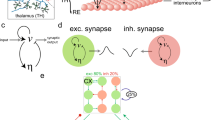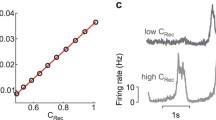Summary
A theory of neocortical interactions is developed involving both local delays (PSP rise and decay times) and global delays due to finite velocity of action potentials in corticocortical fibers. The theory is based on plausible assumptions regarding input/output relations in neocortical columns and realistic neural parameters. The simultaneous existence of short wavelength waves propagating away from multiple epicenters and long wavelength standing waves due to global boundary conditions is predicted. Both phenomena appear to have dominant oscillation frequencies in the general range of observed EEG phenomena in humans. A mechanism by which removal of diffuse input from the reticular formation may cause an abrupt drop in EEG frequency (as in the transition from the awake to sleeping state) is postulated.
Similar content being viewed by others
References
Abeles, M. Local Cortical Circuits. Springer-Verlag, New York, 1982.
Adey, W. R. Electromagnetic field interactions in the brain. In: E. Basar (Ed.), Dynamics of Sensory and Cognitive Processing by the Brain. Springer-Verlag, Berlin, 1988.
Braitenberg, V. Cortical architectonics: general and areal. In: M.A.B. Brazier, H. Petsche (Eds.), Architechtonics of the Cerebral Cortex. Raven Press, New York, 1978.
Cooper R., Winter, A. L., Crow, H. J. and Walter, W. G. Comparison of subcortical, cortical, and scalp activity using chronically indwelling electrodes in man. Electroencephal. Clin. Neruophysiol., 1965, 18: 217–228.
DeLucchi, M. R., Garoutte, B. and Aird, R. B. The scalp as an electroencephalographic averager. Electroencephal. Clin. Neurophysiol., 1975, 38: 93–96.
Freeman, W.J. Mass Action in the Nervous System. Academic Press, New York, 1975.
Freeman, W. J. Analytic techniques used in the search for the physiological basis of the EEG. In: A. S. Gevins and A. Remond (Eds.), Handbook of Electroencephalography and Clinical Neurophysiology. Elsevier, New York, 1987.
Gleick, J. Chaos. Viking, New York, 1987.
Ingber, L. Statistical mechanics of neocortical interactions. Basic formulation. Physica 5D, 1982, 83–107.
Ingber, L. Statistical mechanics of neocortical interactions. Derivation of short-term memory capacity. Phys. Rev. A., 1984, 29: 3346–3358.
Ingber, L. Statistical mechanics of neocortical interactions: EEG dispersion relations. IEEE Trans. Biomed. Eng., 1985, 32: 91–94.
Ingber, L. and Nunez, P. L. Multiple scales of statistical physics of neocortex: application to electroencephalography. Math. Comput. Modelling., 1989, in press.
Katznelson, R.D. Normal modes of the brain: neuroanatomical basis and a physiological theoretical model. In: P.L. Nunez (Ed.), Electric Fields of the Brain: The Neurophysics of EEG. Oxford U Press, New York, 1981.
Katznelson, R.D. Deterministic and Stochastic Field Theoretic Models in the Neurophysics of EEG. Ph.D. Dissertation, U. of Calif. at San Diego, 1982.
Lopes da Silva, F. H., Hoeks, H., Smiths, H. and Zetterberg, H. Model of brain rhythmic activity. Kybernetik, 1974, 15: 27–37.
Lopes da Silva, F.H. and Storm van Leeuwen, W. The cortical alpha rhythm in dog: the depth and surface profile of phase. In: M.A.B. Brazier and H. Petsche (Eds.), Architectonics of the Cerebral Cortex. Raven Press, New York, 1978, 319–333.
Lopes da Silva, F. H. Dynamics of EEGs as signals of neuronal populations: models and theoretical considerations. In: E. Niedermeyer and F.H. Lopes da Silva (Eds.), Electroencephalography. Basic Principles, Clinical Applications and Related Fields. Urban and Schwarzenberg, Baltimore-Munich, 1987, 15–28.
Moon, F. C. Chaotic Vibrations. Wiley, New York, 1987.
Nunez, P.L. The brain wave equation: a model for the EEG. Amer. EEG Soc. Meeting Houston, 1972, and Math Biosciences, 1974a, 21: 279–297.
Nunez, P.L. Wave-like properties of the alpha rhythm. IEEE Trans. Biomed. Eng., 1974b, 21: 473–482.
Nunez, P.L., Reid, L. and Bickford, R.G. The relationship of head size to alpha frequency with implications to a brain wave model. Electroencephal. Clin. Neurophysiol., 1977, 44: 344- 352.
Nunez, P.L. Electric Fields of the Brain: The Neurophysics of EEG. Oxford U. Press, New York, 1981a.
Nunez, P.L. A study of origins of the time dependencies of scalp EEG: I. Theoretical basis. IEEE Trans. Biomed. Eng., 1981b, 28: 271–280.
Nunez, P.L. A study of the origins of the time dependencies of scalp EEG: II. Experimental support of theory. IEEE Trans. Biomed. Eng., 1981c, 28: 281–288.
Nunez, P. L. Spatial filtering and experimental strategies in EEG. In: D. Samson-Dollfus (Ed.), Statistics and Topography in Quantitative EEG. Elsevier, Paris, 1988a.
Nunez, P.L. Global contributions to cortical dynamics: theoretical and experimental evidence for standing wave phenomena. In: E. Basar (Ed.), Dynamics of Sensory and Cognitive Processing by the Brain. Springer-Verlag, New York, 1988b.
Nunez, P. L. Towards a physics of neocortex. In: V.Z. Marmarelis (Ed.), Advanced Methods of Physiological Systems Modeling, vol.2, 1989, in press.
Petsche, H., Pockberger, H. and Rappelsberger, P. On the search for the sources of the electroencephalogram. Neuroscience, 1984, 11: 10–27.
Pfurtscheller, G. and Cooper, R. Frequency dependence of the transmission of the EEG from cortex to scalp. Electroencephal. Clin. Neurophysiol., 1975, 38: 93–96.
Plonsey, R. Bioelectric Phenomena. McGraw-Hill, New York, 1969.
Rall, W.A. A statistical theory of monosynaptic input—output relations, J. Cell. Comp. Physiol., 1955, 46: 373–411.
Rall, W.A. Experimental monosynaptic input—output relations in mammalian spinal cord. J. Cell. Comp. Physiol., 1955, 46: 413–437.
Sholl, D.A. The Organization of the Cerebral Cortex. Wiley, London, 1956.
Szentagothai, J. The neural network of the cerebral cortex: a functional interpretation. Proc. Roy. Soc. Lond., 1978a, 201: 219–248.
Szentagothai, J. Specificity versus (quasi) randomness in cortical connectivity. In: M.A.B. Brazier and H. Petsche (Eds.), Architectonics of the Cerebral Cortex. Raven Press, New York, 1978b, 77–97.
Taylor, C. P., and Dudek, F. E. Excitation of hippocampal pyramidal cells by an electrical field effect. J. Neurophysiol., 1984a, 52: 126–142.
Taylor, C. P. and Dudek, F. E. Synchronization without active chemical synapses during hippocampal afterdischarges. J. Neurophysiol., 1984b, 52: 143–155.
Thatcher, R.W., Krouse, P.J. and Hrybyk, M. Cortico-cortical associations and EEG coherence: a two compartmental model. Electroencephal. Clin. Neurophysiol., 1986, 64: 123–143.
van Rotterdam, A., Lopes da Silva, F.H., van der Ende, J., Viergever, M.A. and Hermans, A.J. A model of the spatialtemporal characteristics of the alpha rhythm. Bull. Math. Biology., 1982, 44: 283–305.
Walter, D.O., Rhodes, J.M., Brown, D. and Adey, W.R. Comprehensive spectral analysis of human EEG generators in posterior cerebral regions. Electroencephal. Clin. Neurophysiol., 1966, 20: 224–237.
Wilson, H. R. and Cowan, J. D. Excitatory and inhibitory interactions in localized populations of model neurons. Biophysics, 12: 1–12.
Wilson, H.R. and Cowan, J.D. A mathematical theory of the functional dynamics of cortical and thalmic nervous tissue. Kybernetik, 1973, 13: 55–80.
Zhadin, M.N. Rhythmic processes in the cerebral cortex. J. Theor. Biol., 1984, 108: 565–595.
Author information
Authors and Affiliations
Additional information
Supported by NSF grant ECE8521101 and NIH grant 1RO1NS243314. The author thanks the editor and referees for very helpful comments.
Rights and permissions
About this article
Cite this article
Nunez, P.L. Generation of human EEG by a combination of long and short range neocortical interactions. Brain Topogr 1, 199–215 (1989). https://doi.org/10.1007/BF01129583
Accepted:
Issue Date:
DOI: https://doi.org/10.1007/BF01129583




